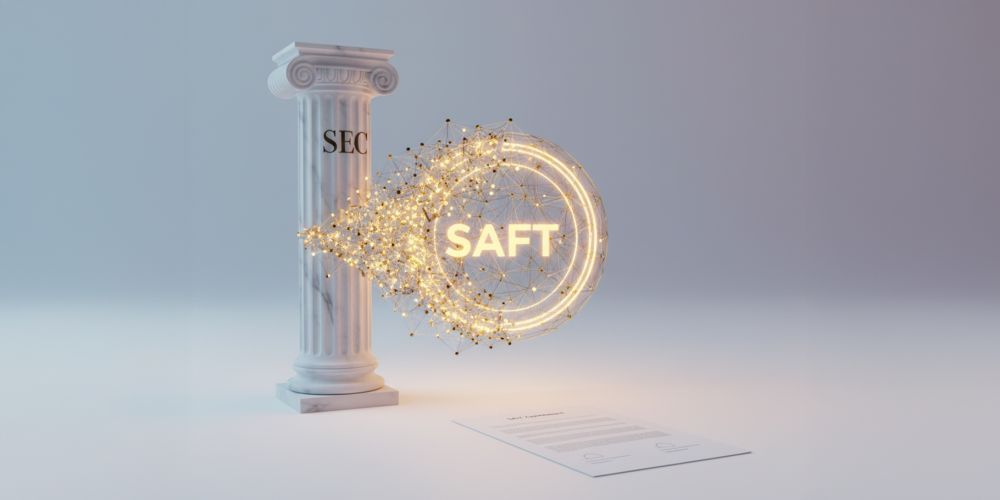SAFT and the SEC: How to Build a Legally Safe Token Agreement

When the crypto market talks about compliance, one three-letter acronym often makes founders nervous — SEC. The U.S. Securities and Exchange Commission remains one of the most influential regulators in the world. For Web3 projects planning to raise funds or distribute tokens, understanding how the SEC views SAFTs — Simple Agreements for Future Tokens — is essential.
SAFT was once seen as the “magic shield” that could protect token issuers from securities law problems. But as the market evolved, that illusion faded. In 2025, the conversation is no longer about whether you can use a SAFT — it’s about how to structure it correctly.
What the SEC Actually Cares About
The SEC doesn’t prohibit innovation. It focuses on one thing: whether an instrument functions as a security.
Even if your project uses a SAFT, the Commission may still apply the Howey Test, asking the classic questions:
-
Is there an investment of money?
-
In a common enterprise?
-
With an expectation of profit?
-
Primarily from the efforts of others?
If the answer is “yes,” the SAFT — or even the tokens it covers — may still be treated as securities.
That’s exactly what happened in the Telegram and Kik cases. Both companies used investment-style token sales and called them SAFTs. The SEC didn’t care about the label — it cared about economic reality. Those cases set a strong precedent: the form of the document doesn’t define legality; the substance does.
Why the SAFT Structure Still Matters
So why do projects still use SAFTs? Because when drafted properly, they can help segment the fundraising process and reduce risk.
A well-designed SAFT separates:
- The fundraising phase — when investors support a project still under development, and
- The token delivery phase — when the network becomes functional, and tokens may no longer be “securities” but “utility assets.”
This logic remains valid, especially when paired with a thorough legal opinion explaining why the eventual tokens are not securities. The key is consistency between your legal documents, business model, and tokenomics.
The SEC’s Current View in 2025
The SEC has become more nuanced than in 2019 or 2020. After years of enforcement actions, it’s clear that the Commission differentiates between:
- Investment contracts, where tokens are tied to speculative profit; and
- Functional tokens, where users interact with an existing network or platform.
Still, the risk remains high if the SAFT promises early access to tokens that don’t yet have a working use case. In that scenario, the SEC tends to see the SAFT as an investment agreement — a form of security.
Some projects have learned this the hard way. Others took a more careful route: working with licensed counsel, obtaining legal opinions, and registering or qualifying their offerings when needed. Those are the projects that survived.
Building a Legally Safe SAFT
If you want your SAFT to hold up under scrutiny, treat it as a compliance framework, not a shortcut.
Here’s what matters most:
- Define clear milestones for token generation and network functionality.
- Avoid marketing the token as an investment opportunity.
- Disclose all risks transparently — this helps both with compliance and investor trust.
- Obtain a jurisdiction-specific legal opinion, especially if investors are in the U.S.
- Use international structuring carefully (e.g., issuing from non-U.S. entities doesn’t automatically exempt you from SEC rules).
- Keep your documentation aligned: the SAFT, white paper, and token terms must tell the same story.
Remember — regulators evaluate substance over form. If your project behaves like an investment, the SEC will treat it as one, regardless of the document title.
The Role of Legal Opinion
A Legal Opinion complements a SAFT by explaining why a token should not be classified as a security — either under the Howey Test, Reves Test, or relevant jurisdictional equivalents.
Exchanges, custodians, and major investors now require such opinions before listing or engaging with tokens.
For founders, this document isn’t just a formality. It’s your project’s legal armor — showing regulators and partners that compliance was part of the design, not an afterthought.
Final Thoughts
The idea behind SAFT was simple: give startups a compliant way to raise funds while developing their network.
But simplicity doesn’t mean safety. In the eyes of the SEC, a SAFT is not a “get-out-of-jail-free” card — it’s just a contract that needs to be built responsibly.
In 2025, the projects that succeed are those that see legal structuring as part of the product itself. They don’t just write code; they build compliance into their codebase.
If you’re developing or fundraising for your token, make sure your SAFT — and everything connected to it — stands up to SEC logic, not just crypto optimism.
Legal Kornet assists blockchain and fintech projects in building compliant token frameworks worldwide — from SAFT drafting to full legal opinions recognized by exchanges and regulators.


